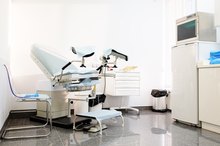Symptoms After Prostate Biopsy
The prostate is a gland that creates some of the fluids found in semen, according to the American Cancer Society 5. Prostate cancer causes the second-highest number of cancer deaths among men. Doctors may use either the prostate-specific antigen blood test, a digital rectal exam, or both as methods of screening for prostate cancer. A prostate biopsy can often determine if there is cancer present. This procedure typically takes about 15 minutes to perform. There are a few symptoms that the patient may experience for several days to weeks after the procedure.
If you are experiencing serious medical symptoms, seek emergency treatment immediately.
Bleeding
After a prostate biopsy, a man may notice bleeding for some time afterward because the biopsied area contains small veins, according to the University of Pittsburgh Cancer Institute 2. Blood may be present in the urine or the stool for several days after the procedure. Blood may also be present in the semen for several weeks after the biopsy. According to MayoClinic.com, if the bleeding becomes very heavy, the patient should contact his physician.
- After a prostate biopsy, a man may notice bleeding for some time afterward because the biopsied area contains small veins, according to the University of Pittsburgh Cancer Institute 2.
- Blood may also be present in the semen for several weeks after the biopsy.
Pain
What Are the Causes of Painful Ejaculation?
Learn More
Physicians typically use local anesthesia for prostate biopsies to minimize any pain or discomfort during the procedure. After the procedure, the patient generally feels some soreness in the area for a few days. If the pain worsens, the patient should let his physician know, according to MayoClinic.com.
Difficulty with Urination
After a prostate biopsy, some men may have a difficult time with urination or be unable to urinate at all. Swelling of the prostate may interfere with urination, according to the Monterey Bay Urology Associates website 4. Only about 1 percent of men who have a prostate biopsy develop this problem after the procedure. According to MayoClinic.com, patients should report this condition to their physicians as well.
- After a prostate biopsy, some men may have a difficult time with urination or be unable to urinate at all.
Infection
A Lump in the Testicle After a Vasectomy
Learn More
During the biopsy procedure, some bacteria from the rectum may be transferred to the prostate, according to reports from Weiss Memorial Hospital 3. Most of the time, the patient will be prescribed antibiotics before and after the procedure, which lowers the risk of infection. However, about 1 percent of men develop an infection after a prostate biopsy. According to MayoClinic.com, if symptoms like fever, pain during urination, or a discharge from the penis occur after a prostate biopsy, the patient needs to alert his physician for further evaluation and treatment 1.
Related Articles
References
- MayoClinic.com: Prostate Biopsy - What You Can Expect?
- Monterey Bay Urology Associates: Prostate Ultrasound and Biopsy
- American Cancer Society: How is Prostate Cancer Found?
- Roberts MJ, Teloken P, Chambers SK, et al. Prostate Cancer Detection. [Updated 2018 Jun 11]. In: Feingold KR, Anawalt B, Boyce A, et al., editors. Endotext [Internet]. South Dartmouth (MA): MDText.com, Inc.; 2000-.
- Tikkinen KAO, Dahm P, Lytvyn L, et al. Prostate cancer screening with prostate-specific antigen (PSA) test: a clinical practice guideline. BMJ. 2018;362:k3581.
- Naji L, Randhawa H, Sohani Z, et al. Digital Rectal Examination for Prostate Cancer Screening in Primary Care: A Systematic Review and Meta-Analysis. Ann Fam Med. 2018;16(2):149-154.
- Leslie SW, Soon-Sutton TL, Sajjad H, et al. Prostate Cancer. [Updated 2019 Oct 8]. In: StatPearls [Internet]. Treasure Island (FL): StatPearls Publishing; 2019 Jan-.
- Guo G, Xu Y, Zhang X. TRUS-guided transperineal prostate 12+X core biopsy with template for the diagnosis of prostate cancer. Oncol Lett. 2017;13(6):4863–4867. doi:10.3892/ol.2017.6051
- Wegelin O, Exterkate L, Van der leest M, et al. The FUTURE Trial: A Multicenter Randomised Controlled Trial on Target Biopsy Techniques Based on Magnetic Resonance Imaging in the Diagnosis of Prostate Cancer in Patients with Prior Negative Biopsies. Eur Urol. 2019;75(4):582-590.
- Applewhite JC, Matlaga BR, Mccullough DL, Hall MC. Transrectal ultrasound and biopsy in the early diagnosis of prostate cancer. Cancer Control. 2001;8(2):141-50.
- Xiang J, Yan H, Li J, Wang X, Chen H, Zheng X. Transperineal versus transrectal prostate biopsy in the diagnosis of prostate cancer: a systematic review and meta-analysis. World J Surg Oncol. 2019;17(1):31. Published 2019 Feb 13. doi:10.1186/s12957-019-1573-0
- Young MJ, Elmussareh M, Morrison T, Wilson JR. The changing practice of transurethral resection of the prostate. Ann R Coll Surg Engl. 2018;100(4):326-329.
- Quon JS, Moosavi B, Khanna M, Flood TA, Lim CS, Schieda N. False positive and false negative diagnoses of prostate cancer at multi-parametric prostate MRI in active surveillance. Insights Imaging. 2015;6(4):449–463. doi:10.1007/s13244-015-0411-3
- Uriburu-Pizarro F, Kasivisvanathan V, Puech P, Villers A. Pre-biopsy MRI as an adjunct for cancer detection in men with elevated PSA and no previous biopsy. Transl Androl Urol. 2017;6(3):387–394. doi:10.21037/tau.2017.01.19
- Jones TA, Radtke JP, Hadaschik B, Marks LS. Optimizing safety and accuracy of prostate biopsy. Curr Opin Urol. 2016;26(5):472–480. doi:10.1097/MOU.0000000000000310
- Loeb S, Vellekoop A, Ahmed HU, et al. Systematic review of complications of prostate biopsy. Eur Urol. 2013;64(6):876-92.
- Kaewlai R, Abujudeh H. Nephrogenic systemic fibrosis. AJR Am J Roentgenol. 2012;199(1):W17-23.
- Pickles K, Carter SM, Rychetnik L. Doctors' approaches to PSA testing and overdiagnosis in primary healthcare: a qualitative study. BMJ Open. 2015;5(3):e006367. Published 2015 Mar 17. doi:10.1136/bmjopen-2014-006367
- Chowdhury R, Abbas A, Idriz S, Hoy A, Rutherford EE, Smart JM. Should warfarin or aspirin be stopped prior to prostate biopsy? An analysis of bleeding complications related to increasing sample number regimes. Clin Radiol. 2012;67(12):e64-70.
- Marguet C, Raj GV, Brashears JH, et al. Rectourethral fistula after combination radiotherapy for prostate cancer. Urology. 2007;69(5):898-901.
- Punnen S, Nam RK. Indications and timing for prostate biopsy, diagnosis of early stage prostate cancer and its definitive treatment: a clinical conundrum in the PSA era. Surg Oncol. 2009;18(3):192-9.
- Nassiri N, Natarajan S, Margolis DJ, Marks LS. Targeted Prostate Biopsy: Lessons Learned Midst the Evolution of a Disruptive Technology. Urology. 2015;86(3):432–438. doi:10.1016/j.urology.2015.07.001
- Hong CW, Amalou H, Xu S, et al. Prostate biopsy for the interventional radiologist. J Vasc Interv Radiol. 2014;25(5):675–684. doi:10.1016/j.jvir.2013.12.568
- Altok, M., Ward, J., Chapin, B. et al. Cost Analysis of Different Prostate Biopsy Modalities. The Journal of Urology. 2017. 197(4):e821.
- Schlenker B, Apfelbeck M, Buchner A, Stief C, Clevert DA. MRI-TRUS fusion biopsy of the prostate: Quality of image fusion in a clinical setting. Clin Hemorheol Microcirc. 2018;70(4):433-440.
- Wang J, Wang L, Du Y, et al. Addition of intrarectal local analgesia to periprostatic nerve block improves pain control for transrectal ultrasonography-guided prostate biopsy: a systematic review and meta-analysis. Int J Urol. 2015;22(1):62-8.
- Li M, Wang Z, Li H, et al. Local anesthesia for transrectal ultrasound-guided biopsy of the prostate: A meta-analysis. Sci Rep. 2017;7:40421.
- Hiros M, Selimovic M, Spahovic H, Sadovic S, Spuzic-celic E. Transrectal ultrasound-guided prostate biopsy, periprostatic local anesthesia and pain tolerance. Bosn J Basic Med Sci. 2010;10(1):68-72.
- Bjurlin MA, Wysock JS, Taneja SS. Optimization of prostate biopsy: review of technique and complications. Urol Clin North Am. 2014;41(2):299–313. doi:10.1016/j.ucl.2014.01.011
- Abdelkhalek M, Abdelshafy M, Elhelaly H, Kamal M. Hemosepermia after transrectal ultrasound-guided prostatic biopsy: A prospective study. Urol Ann. 2013;5(1):30–33. doi:10.4103/0974-7796.106963
- Ozveren B, Türkeri L. Massive rectal bleeding after prostate biopsy controlled by endoclipping in a patient using acetylsalicylic acid. Can Urol Assoc J. 2013;7(5-6):E442–E444. doi:10.5489/cuaj.1390
- Shariat SF, Roehrborn CG. Using biopsy to detect prostate cancer. Rev Urol. 2008;10(4):262–280.
- Gordetsky J, Epstein J. Grading of prostatic adenocarcinoma: current state and prognostic implications. Diagn Pathol. 2016;11:25. Published 2016 Mar 9. doi:10.1186/s13000-016-0478-2
- Billis A. Prostatic atrophy. Clinicopathological significance. Int Braz J Urol. 2010;36(4):401-9.
- Davis NG, Silberman M. Bacterial Acute Prostatitis. [Updated 2019 Feb 28]. In: StatPearls [Internet]. Treasure Island (FL): StatPearls Publishing; 2019 Jan-.
- Armah HB, Parwani AV. Atypical adenomatous hyperplasia (adenosis) of the prostate: a case report with review of the literature. Diagn Pathol. 2008;3:34. Published 2008 Aug 12. doi:10.1186/1746-1596-3-34
- Brawer MK. Prostatic intraepithelial neoplasia: an overview. Rev Urol. 2005;7 Suppl 3(Suppl 3):S11–S18.
- Adamczyk P, Wolski Z, Butkiewicz R, Nussbeutel J, Drewa T. Significance of atypical small acinar proliferation and extensive high-grade prostatic intraepithelial neoplasm in clinical practice. Cent European J Urol. 2014;67(2):136–141. doi:10.5173/ceju.2014.02.art4
- Celma A, Servián P, Planas J, et al. Clinical significance of proliferative inflammatory atrophy in prostate biopsy. Actas Urol Esp. 2014;38(2):122-6.
- Chen N, Zhou Q. The evolving Gleason grading system. Chin J Cancer Res. 2016;28(1):58–64. doi:10.3978/j.issn.1000-9604.2016.02.04
- Magi-galluzzi C, Montironi R, Epstein JI. Contemporary Gleason grading and novel Grade Groups in clinical practice. Curr Opin Urol. 2016;26(5):488-92.
- Altok, M., Ward, J., Chapin, B. et al. Cost Analysis of Different Prostate Biopsy Modalities. The Journal of Urology. 2017. 197(4):e821.
- American Urological Association. The Prevention and Treatment of the More Common Complications Related to Prostate Biopsy Update. Updated 2016.
- Li, M., Wang, Z., Li, H. et al. Local Anesthesia for Transrectal Ultrasound Guided Biopsy of the Prostate: A Meta-Analysis. Scientific Reports. 2017. 7(1):40421.
- Loeb, S., Vellekoop, A., Ahmed, H. et al. Systematic Review of Complications of Prostate Biopsy. European Urology. 2013. 64(4):876-892.
- Quon, J., Moosavi, B., Khanna, M. et al. False Positive and False Negative Diagnoses of Prostate Cancer at Multi-Parametric Prostate MRI in Active Surveillance. Insights into Imaging. 2015. 6(4):449-463.
- Schoots, I., Roobol, M., Nieboer, D. et al. Magnetic Resonance Imaging-Targeted Biopsy May Enhance the Diagnostic Accuracy of Significant Prostate Cancer Detection Compared to Standard Transrectal Ultrasound-Guided Biopsy: A Systematic Review and Meta-Analysis. European Urology. 2015. 68(3):438-450.
- U.S. National Library of Medicine. MedlinePlus. Prostate Biopsy. Updated 08/31/18.
- Wang, J., Wang, L., Du, Y. et al. Addition of Intrarectal Local Anesthesia to Periprostatic Nerve Block Improves Pain Control for Transrectal Ultrasonography-Guided Prostate Biopsy: A Systematic Review and Meta-Analysis. International Journal of Urology. 2015. 22(1):62-68.
Writer Bio
Dominique Brooks has been a medical editor for over 10 years. She has worked in medical education for physicians, nurses and pharmacists as well as consumers. She started writing business articles for Work.com in 2008 and health articles online in 2009. She holds a Master of Business Administration from the University of Alabama and a Doctor of Medicine from Vanderbilt University.









